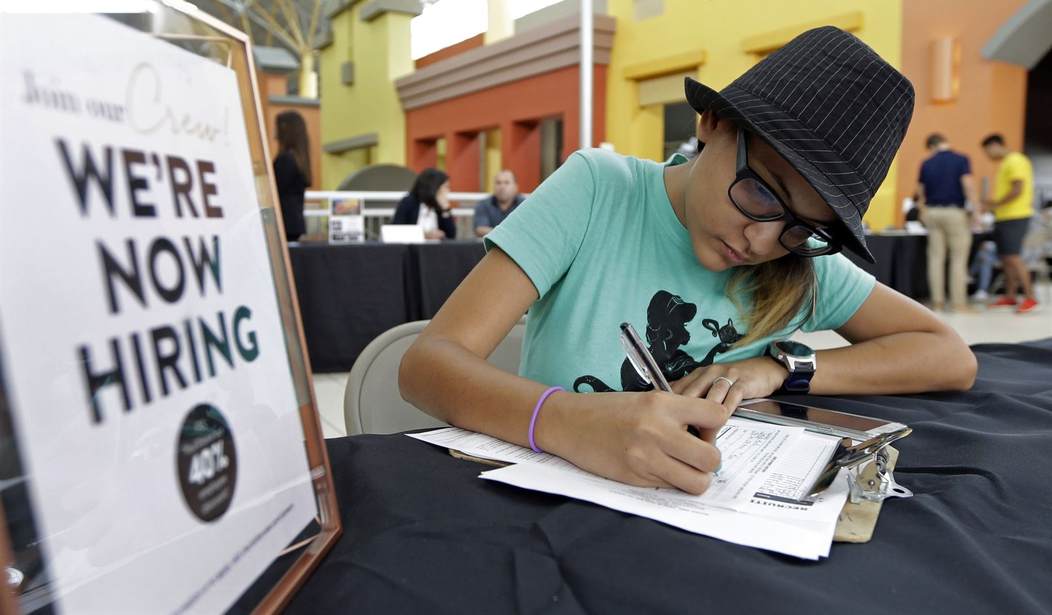How much does one week matter? Probably not a lot, besides which the media has mainly focused on the wrong metric. Initial weekly jobless claims unexpectedly rose by 37,000 in today’s report, a reversal in the string of weekly declines. The four-week average still dipped below 400K for the first time in the pandemic, however:
In the week ending June 12, the advance figure for seasonally adjusted initial claims was 412,000, an increase of 37,000 from the previous week’s revised level. The previous week’s level was revised down by 1,000 from 376,000 to 375,000. The 4-week moving average was 395,000, a decrease of 8,000 from the previous week’s revised average. This is the lowest level for this average since March 14, 2020 when it was 225,500. The previous week’s average was revised up by 500 from 402,500 to 403,000.
The advance seasonally adjusted insured unemployment rate was 2.5 percent for the week ending June 5, unchanged from the previous week’s unrevised rate. The advance number for seasonally adjusted insured unemployment during the week ending June 5 was 3,518,000, an increase of 1,000 from the previous week’s revised level. The previous week’s level was revised up 18,000 from 3,499,000 to 3,517,000. The 4-week moving average was 3,603,750, a decrease of 55,000 from the previous week’s revised average. This is the lowest level for this average since March 21, 2020 when it was 2,071,750. The previous week’s average was revised up by 7,500 from 3,651,250 to 3,658,750.
On one hand, a single week’s report isn’t exactly a bellwether. However, this seems like a strange place for a plateau on initial weekly jobless claims. It’s well above the level for a healthy job market, and far above the pre-pandemic levels in the lower 200Ks. The four-week averages are better benchmarks, but that’s not much comfort here either. A four-week average of 395K is not a sign of a healthy job market.
CNBC points out that the bump sets the trends back by a month, and that this was a big miss agains expectations:
Initial jobless claims unexpectedly rose last week despite an ongoing recovery in the U.S. employment market, the Labor Department reported Thursday.
First-time filings for unemployment insurance for the week ended June 12 totaled 412,000, compared with the previous week’s 375,000. That was the highest number since May 15.
Economists surveyed by Dow Jones had been expecting 360,000 new claims for last week.
The problem might be more localized than it appears, however:
All of the increase essentially came from two states – Pennsylvania saw a gain of 21,590, while California rose 15,712, according to unadjusted data.
CNBC also asserts that this comes amid progress toward “normalcy,” but that’s only true in the most incremental of ways. The topline aside, the labor market is very much abnormal still, in a way that this metric doesn’t illustrate. These numbers only capture the movement in traditional state unemployment programs. It leaves out those receiving benefits in the pandemic-relief programs that have been extended through September by Congress. There are over 11.2 million claims continuing in those programs, far outstripping the 3.52 million receiving traditional unemployment benefits.
That’s a huge labor overhang that traditional jobs reporting fails to capture or provide an accounting for. The unemployment measures — certainly U-3 but also U-6 to a certain extent — aren’t capturing it. It’s those workers whose absence contributes to supply-chain issues that create inflationary pressures in the economy (along with other unrelated inflationary pressures), and whose eventual return to the labor force will be massively disruptive to wages and metrics.
Until we remove the perverse incentives we have introduced and work through the distortions they have created, we won’t begin to approach “normalcy.”









Join the conversation as a VIP Member